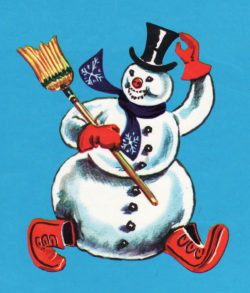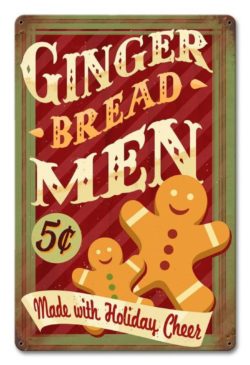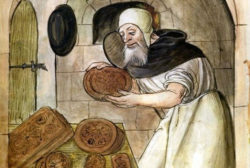In this video, Jim Thomas discusses the origins and history of Santa Pin-Back Buttons beginning in the 1910–1920s with the Red Cross/NTA Buttons and touches on each decade thereafter. He discusses sizes, makers, promotions, themes, and categories, add-ons, and more. Jim has more than 300 buttons in his collections. Jim’s passion for Santa Pin-Back Buttons…
Category: Knowledge Articles
Santa Claus Postcards – Colorful Records of Yuletide Past VIDEO
In this video, Jim Thomas introduces the art of collecting Santa Claus Postcards. He breaks the collectible categories down by Subject/Topics, Artist/Dates, and Series/Variations, as well as postcard types including Embossed, Mechanical, Add-Ons, Fade-A-Ways, Silks, Non-Color, Real Photos, Hold-to-Light, Transparencies, and touches briefly on Non-U.S. postcards. Jim draws examples from his and his wife Pam’s…
“Christmas Movies and Music” – 2019 Minnesota October Event
“Christmas Movies and Music” Flimstrip On the second weekend in October 2019, the Minnesota contingent of Glow members and neighboring friends gathered at the Eagan Community Center for the 32nd annual Minnesota October Event (MOE). Sixty-three enthusiasts, including folks from six additional states, came to celebrate and participate in the weekend. The theme of this…
Frosty the Snowman
Frosty the Snowman is a lucky guy! Why, you say? Well, Frosty is in the middle of celebrating TWO birthdays! That’s right…TWO! How is that possible? Let us tell you all about it.
We recently celebrated the 50th anniversary of the first airing of the Rankin/Bass Productions TV cartoon special Frosty the Snowman. It has been shown for 50 consecutive years since December 7, 1969. But, Frosty began his life much earlier. In 1950, two songwriters wanted to produce something that would compete with the popularity of “Rudolph the Red-Nosed Reindeer.” Walter E. “Jack” Rollins and Steve Nelson came up with the idea of Frosty, but not as a Christmas song. They gave it to Gene Autry, who had been looking for a follow-up to “Rudolph,” to record, and it became an instant hit. Jimmy Durante, Nat King Cole, and Guy Lombardo also had hits with Frosty that placed on the record charts that same year!






Just like Rudolph, Frosty merchandise was produced to help market the song and the character.
The merchandising was taken up by Sears and similar items that had appeared for Rudolph were marketed for Frosty…books, records, pins, a few toys, some clothing, and the ever-popular snow globes. Comic books, coloring books, and puzzles soon followed. However, Sears did not follow through with the merchandising like Robert May and Montgomery Ward did for Rudolph.



Miller Electric was granted the rights to the early Frosty and designed several color variations in hard plastic with a light. Also in the early 1950’s, UPA Studios produced a black and white 3 minute long short of Frosty the Snowman with the original song. It is readily available on YouTube and is televised each Christmas on WGN TV in Chicago.


Arthur Rankin, Jr. and Jules Bass (Rankin/Bass Productions, Inc.) acquired the rights to “Frosty.” Their animators redesigned Frosty’s appearance, as they had done earlier with Rudolph. They hired Romeo Muller again to write a backstory for Frosty as he had done with Rudolph. Muller had previously been a writer for Jack Envy and Milton Berle. He added the characters to the story of Frosty. He continued to work with Rankin and Bass and did other films including Santa Claus Is Comin’ to Town (1970), The Little Drummer Boy (1968), and Here Comes Peter Cottontail (1971).



Rankin and Bass wanted this Christmas special to look like a greeting card. In order to get just the right look, they had greeting card artist, Paul Coker, Jr., who also worked for Mad Magazine, do the background and all of the character initial drawings. Then, those drawings were used to do the animation the old fashioned way, with the creation of cells.


Jimmy Durante was chosen to sing the song and he became the narrator of the story, with his own character. Jackie Vernon, a stand-up comedian, became the voice of Frosty. June Foray was the original voice of Karen during the special’s first few airings; however, her voice was eventually replaced. Foray was also the voice of Cindy Lou Who in How The Grinch Stole Christmas and probably most famous for being the voice of Rocky the Flying Squirrel. Billy De Wolfe, after many years appearing on various TV programs, his voice will ever be known as Professor Hinkle. Paul Frees, the voice of the traffic cop, the railroad ticket agent, and Santa Claus, worked with many studios doing voices for cartoons and movies alike. He is most notably remembered as Boris Badenov on the Rocky and Bullwinkle Show.










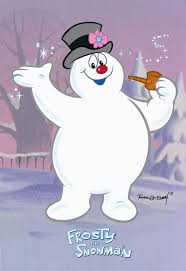
TV Guide rated Frosty as number 4 on the most family friendly Christmas Special list. The original version of the song, “Frosty the Snowman,” ended with the line, “I’ll be back again some day.” For the TV version, Jimmy Durante re-recorded the song with the last line of the song being, “I’ll be back on Christmas Day,” making it an “official” Christmas song! That’s what we remember now, Frosty returning at Christmas.
While we celebrated the Rankin/Bass Frosty on his 50th birthday on December 7, 2019, we are now celebrating Frosty’s 70th birthday this year. See, we told you he was a lucky guy and gets to celebrate 2 special birthdays! No matter how old Frosty is, we all look forward to his showing up during the winter and Christmas seasons. Everyone knows that there is always magic in Christmas snow! Right, Frosty?
Celebrating the Holidays in Russia
Dear Friends, I have been asked to write about Russian traditions about celebrating a New Year. It is our favorite holiday, much more than Christmas. Actually we only started once again to celebrate Christmas in 1991. It was celebrated earlier in Russia, before the revolution in 1917. Our New Year celebrations started in the middle…
Gingerbread Men
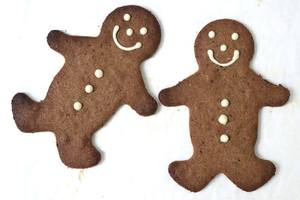
When you think about gingerbread at Christmas, probably the first thing that comes to mind is the flat, spicy cookie that is made into men whose heads you bite off! Did you ever wonder why “gingerbread men” are shaped like men in the first place? The answer can be traced back hundreds of years.
Queen Elizabeth I, who reigned from 1558-1603, is credited with the invention of the gingerbread man. (I am not kidding!) She loved throwing lavish royal dinners that included things like marzipan shaped like fruit, castles and birds. But, the Queen’s court also included a royal gingerbread maker. (More about these bakers a little later.) Elizabeth delighted in having her gingerbread maker bake gingerbread men made in the likenesses of visiting dignitaries and people from her court. I wonder if these gingerbread men were placed on a serving platter to allow guests to choose any one they wanted. Just imagine the satisfaction of biting off the head of someone you really did not like!
But, the Queen wasn’t the only person eating gingerbread men. Taking their lead from the Queen, gingerbread men were often handed out by folk medicine practitioners (often known as magicians and witches). These gingerbread men were created as “love tokens” for young women. The idea was to get the man you’d like to marry to eat the gingerbread man! Tadah! A trip down the aisle was in your future! Well that was what the magician/witch told you. A contemporary to Elizabeth was none other than William Shakespeare. In Loves Labor’s Lost, he wrote this, “An I had but one penny in the world, thou shouldst have it to buy gingerbread.” I guess William really liked gingerbread.
So, how did gingerbread cookies become something to eat around the holidays? Through the ages, gingerbread was sacred and only specific bakers, all men, were given the exclusive rights to baking it. These men all belonged to baking guilds. The only time during the year that gingerbread was allowed to be made by the general public was during Christmas and Easter. So, that’s most likely why it’s seen as a Christmas food. It’s all in the timing! Once an association is established, it’s nearly impossible to change it. Eating gingerbread at Christmas might also be associated with the medicinal properties of the ginger root. It was believed that eating spices heated you up in the winter. Another explanation may be related to overeating during the holidays. Ginger is good at taming upset stomachs. Remember when you were a kid and you were given flat ginger ale when you had an upset tummy?
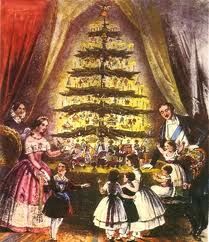
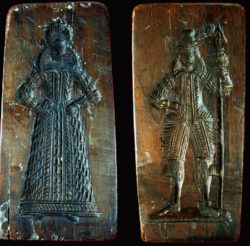
The popularity of gingerbread cookies and houses spread to colonial America. Recipes for the treat varied from region to region, depending upon what immigrants settled there. In 1848, it is said that Queen Victoria and her German-born husband Prince Albert, brought gingerbread cookies into the mainstream when they included them in with other German Christmas traditions they adopted and promoted as family centered traditions, like decorating a Christmas tree and the Yule log. It was during this time that gingerbread cookies became associated primarily with the Christmas holiday.
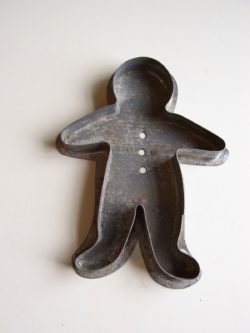
The development of tin cookie cutters in the mid-1800s also helped to establish gingerbread cookies in many kitchens and breathed new life into the tradition of gingerbread. The new cookie cutters proclaimed the end of the long-established and complicated cookie board used primarily in bakeries. Soon, these shaped cookies began to appear as ornaments on trees and as gifts for family and friends.
Today, gingerbread cookies are as popular as ever, becoming an established Christmas tradition in America. If reading this blog post has made you hungry for gingerbread men, perhaps you are off to make some for yourself. I have the perfect idea for enjoying them after baking them. Why not sit down with your favorite beverage and The Glow magazine? What a great combination!

